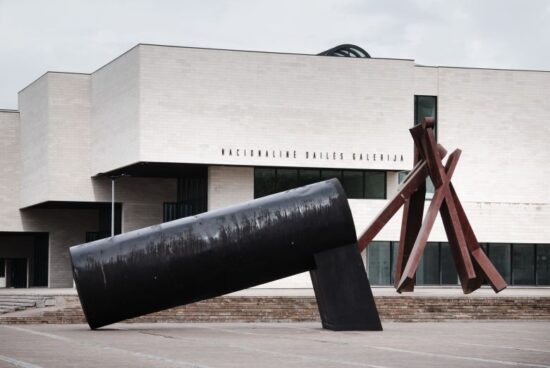Mindaugas Navakas

Photo by Tomas Kapočius
Mindaugas Navakas (born 1952), active since the early 1980s, has contributed significantly to the transformation of the understanding of sculpture in Lithuania. In his monumental sculptures, one can recognize a combination of overlapping forms of the archaic past, classical Western civilisation, minimalism, and Soviet modernism. For his sculptures, he uses brutal industrial materials, such as iron, concrete and steel, and appropriates mass-produced products, such as large-scale water tanks, construction waste containers, beams, lorry curtains, ceramics, etc., by changing the nature of their functionality and transforming them into new formations. The targets of Navakas’s work line up in the discourse of power. Often with an ironic spin, he creates monumental commentaries on socio-political and socio-cultural issues. One of his later works, ‘Smash the Windows, Snatch the Crystals’ (2009), was constructed from old aluminium window frames and glass, which belonged to the Contemporary Art Centre (the former Vilnius Art Exhibition Palace, the first Soviet modernist “white cube” exhibition space in Lithuania) and was decorated with crystals. Made especially for the Frieze Art Fair, the work contains many historical and political references both to the art scene and the East-West discourse.
One of his latest exhibitions, ‘Objectivities’ (2019), presented at the Contemporary Art Centre in Vilnius, is a compact theme-focussed project showcasing different trajectories in Navakas’ work developed over the last few years. In this exhibition, he combines monumental stone elements with smaller-scale plastics, where he embarks on a novel exploration of the sociocultural meanings of the materials that interest him – imported exotic granite, cheap wallpaper, rubber covers, mattresses, and kitchen utensils. Navakas remains committed to his enduring interests but also employs new stone-processing technologies, lean and unusual ways of using them, while referencing the current social and economic contexts of their origin and application. In this exhibition, he carries out a precise and conceptual study of the fundamental features of minimalist structure, with an emphasis on material, volume, proportion, and context. Navakas presents the monumental aspects of his work in an intimate interior situation, inviting the viewer into a total installation, specifically designed for the given location.[Text Wrapping Break]
Navakas’s works have been presented at the Lithuanian pavilion at the Venice Biennale (1999); he developed a special project for the Frieze Art Fair (2009), and has participated in a number of North European biennials, as well as the Gwangju Biennale (1995). He has developed large-scale sculptural projects in Berlin, Busan (South Korea), Tranøy in Hamarøy (Norway), and Vilnius. He has had over a dozen solo exhibitions, including those held at the National Gallery of Art in Vilnius, the Latvian National Museum of Art, the Polish Sculpture Centre in Orońsko (Poland), and Kumu Art Museum in Tallinn. Navakas has been awarded the Herder Prize (1995), the Lithuanian National Culture and Art Prize (1999), and the Baltic Assembly Prize (2004)